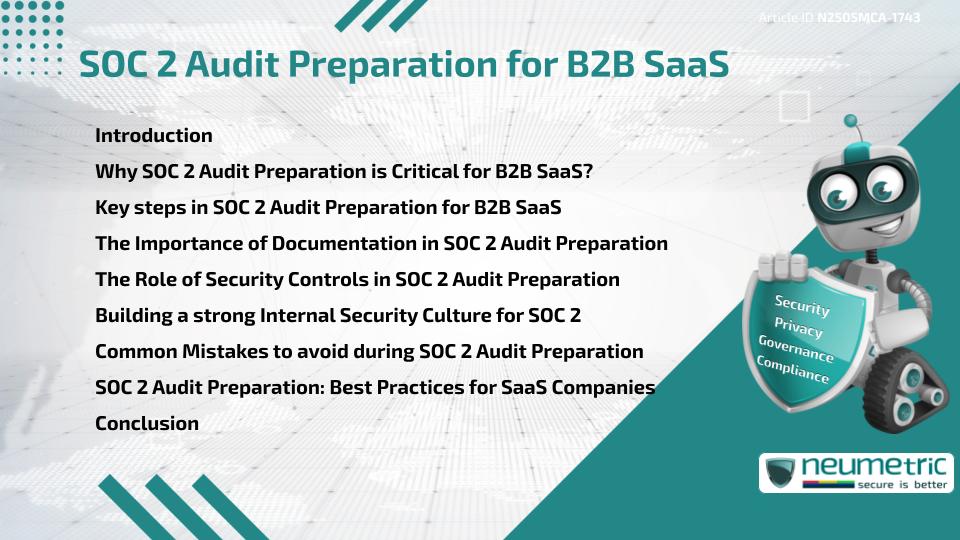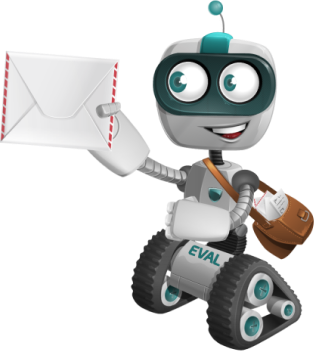Table of Contents
ToggleIntroduction
System & Organisation Controls [SOC 2] is a Framework designed to ensure the Security & Privacy of Data handled by Service Organisations. For B2B Software as a Service [SaaS] Companies, SOC 2 Audit Preparation is essential not only to meet regulatory requirements but also to establish Credibility & Trust with Customers. As more Organisations move to Cloud-based Solutions, ensuring that SaaS Businesses are prepared for a SOC 2 Audit can help mitigate Risks, enhance Internal Controls & demonstrate a commitment to Security.
This article will walk you through the importance of SOC 2 Audit Preparation for B2B SaaS Companies, detailing key steps, common mistakes & best practices to follow for a smooth Audit process.
Why SOC 2 Audit Preparation is Critical for B2B SaaS?
SOC 2 Audits assess a Company’s adherence to the Trust Services Criteria [TSC], which cover five key principles: Security, Availability, Processing Integrity, Confidentiality & Privacy. These principles are essential to maintaining a secure & reliable service for Customers.
For B2B SaaS Companies, SOC 2 Audit Preparation ensures that they meet Industry Standards, allowing them to build trust with Clients who rely on the security of their Data. A successful Audit can also serve as a competitive advantage, as Clients often look for SOC 2-Compliant Vendors before entering into Business relationships.
Key steps in SOC 2 Audit Preparation for B2B SaaS
1. Understand the Trust Services Criteria
The first step in SOC 2 Audit Preparation is to familiarise yourself with the Trust Services Criteria [TSC]. These criteria provide the foundation for assessing the effectiveness of your Internal Controls. Understanding each principle & how it applies to your SaaS Environment is crucial for a successful Audit.
2. Establish Clear Security Policies & Procedures
Documenting your Company’s Security Policies & Procedures is essential. These documents should cover everything from data Access Controls to Incident Response Protocols. Clear documentation not only ensures your Company is aligned with SOC 2 requirements but also serves as a reference during the Audit process.
3. Implement Security Controls
Security Controls are the backbone of SOC 2 Compliance. These include both Technical Controls (e.g., Encryption, Firewalls & Access Management) & Operational Controls (e.g., Employee Training, Monitoring). By implementing robust Controls, you can demonstrate that your Company is actively mitigating Risks.
4. Conduct Internal Audits & Risk Assessments
Before the formal SOC 2 Audit, conducting Internal Audits & Risk Assessments helps identify Vulnerabilities & Gaps in your Security Practices. This proactive approach allows you to address any weaknesses before the External Auditors come in.
5. Choose the Right Audit Firm
Selecting a qualified Audit Firm is critical for the success of the SOC 2 Audit. Look for Firms with experience in Auditing B2B SaaS Companies, as they will be familiar with the unique challenges of the Industry.
The Importance of Documentation in SOC 2 Audit Preparation
Proper documentation is a cornerstone of SOC 2 Audit Preparation. Without clear, well-organised Documentation, it is difficult for Auditors to assess your Controls & Procedures. Common documentation requirements include:
- Security Policies & Procedures
- Incident Response Plans
- System Architecture Diagrams
- Employee Training Records
- Access Control Lists
Having these Documents readily available ensures a smooth & efficient Audit process, saving Time & reducing Stress.
The Role of Security Controls in SOC 2 Audit Preparation
Security Controls are the Technical & Administrative safeguards your Company implements to protect Sensitive Data. These Controls are designed to prevent Unauthorised Access, ensure Data Integrity & maintain Service Availability.
For B2B SaaS Companies, Security Controls often include:
- Data Encryption: Ensuring that data in transit & at rest is encrypted using Industry-standard Protocols.
- Access Management: Restricting access to sensitive systems based on Job Roles & Responsibilities.
- Monitoring & Logging: Continuously monitoring systems for potential Security Incidents & keeping Logs for future Audits.
By demonstrating that these Security Controls are effective & consistent, you can ensure a successful SOC 2 Audit.
Building a strong Internal Security Culture for SOC 2
A strong internal security culture is crucial for SOC 2 Audit Preparation. Employees at all levels should understand the importance of Security & be trained in Best Practices. This includes regular Security Awareness Training, ensuring that all Staff Members are aware of their roles in maintaining Security & Compliance.
Common Mistakes to avoid during SOC 2 Audit Preparation
While preparing for a SOC 2 Audit, many Companies make common mistakes that can delay the process or result in a failed Audit. Some of these include:
- Inadequate Documentation: Failing to document Security Policies, Procedures & Controls can lead to complications during the Audit.
- Weak Internal Controls: Not having sufficient Security Controls in place can result in Audit Failures.
- Lack of Employee engagement: Employees should be aware of the Security Policies & be actively involved in Security Practices.
SOC 2 Audit Preparation: Best Practices for SaaS Companies
1. Start Early
SOC 2 Audit Preparation can take several months, especially for B2B SaaS Companies that need to implement & document Controls. Start early to ensure you have enough time to address any Gaps or Issues.
2. Engage with Experts
Consider working with Security Consultants or Audit Firms that specialise in SOC 2 Compliance. Their expertise can help guide you through the preparation process & ensure you meet all the requirements.
3. Regularly review & update your Security Controls
Security is not static & neither should your Controls be. Regularly review & update your Security Practices to address evolving Threats & ensure ongoing compliance with SOC 2.
Conclusion
Successfully navigating SOC 2 Audit Preparation is more than just a Compliance exercise, it is an opportunity to reinforce your Company’s commitment to Data Protection & Operational Excellence. For SaaS providers, adopting a Systematic & Informed approach can help distinguish your Company in a Competitive Marketplace. With the right mindset, resources & continuous focus on evolving security needs, SOC 2 readiness becomes a valuable asset in building long-term Customer Trust.
Takeaways
- SOC 2 Audit Preparation for B2B SaaS Companies is essential for demonstrating Security, Trust & Reliability.
- Key steps include understanding the Trust Services Criteria, implementing Security Controls & preparing thorough Documentation.
- Avoid common mistakes like inadequate Documentation & weak Internal Controls.
- Building a strong security culture & engaging Experts can ensure a smooth Audit process.
FAQ
What is SOC 2 & why is it important for B2B SaaS Companies?
SOC 2 is a Framework for assessing the security of a Company’s Systems & Data Management. It is important for B2B SaaS Companies to demonstrate Security & build Trust with Clients.
How much time is usually needed to get ready for a SOC 2 Audit?
Preparing for a SOC 2 Audit can take a few months, largely based on how complex your Systems are & how mature your Internal Controls have become.
What are the primary Trust Services Criteria considered in SOC 2?
The Trust Services Criteria for SOC 2 are Security, Availability, Processing Integrity, Confidentiality & Privacy.
How can I ensure a successful SOC 2 Audit for my B2B SaaS Company?
To ensure a successful Audit, start early, implement robust Security Controls, maintain thorough Documentation & engage with Experts.
What are the common mistakes Companies make during SOC 2 Audit Preparation?
Common mistakes include inadequate Documentation, weak Security Controls & lack of Employee Engagement in Security Practices.
Need help?
Neumetric provides organisations the necessary help to achieve their Cybersecurity, Compliance, Governance, Privacy, Certifications & Pentesting goals.
Organisations & Businesses, specifically those which provide SaaS & AI Solutions, usually need a Cybersecurity Partner for meeting & maintaining the ongoing Security & Privacy needs & requirements of their Clients & Customers.
SOC 2, ISO 27001, ISO 42001, NIST, HIPAA, HECVAT, EU GDPR are some of the Frameworks that are served by Fusion – a centralised, automated, AI-enabled SaaS Solution created & managed by Neumetric.
Reach out to us!


